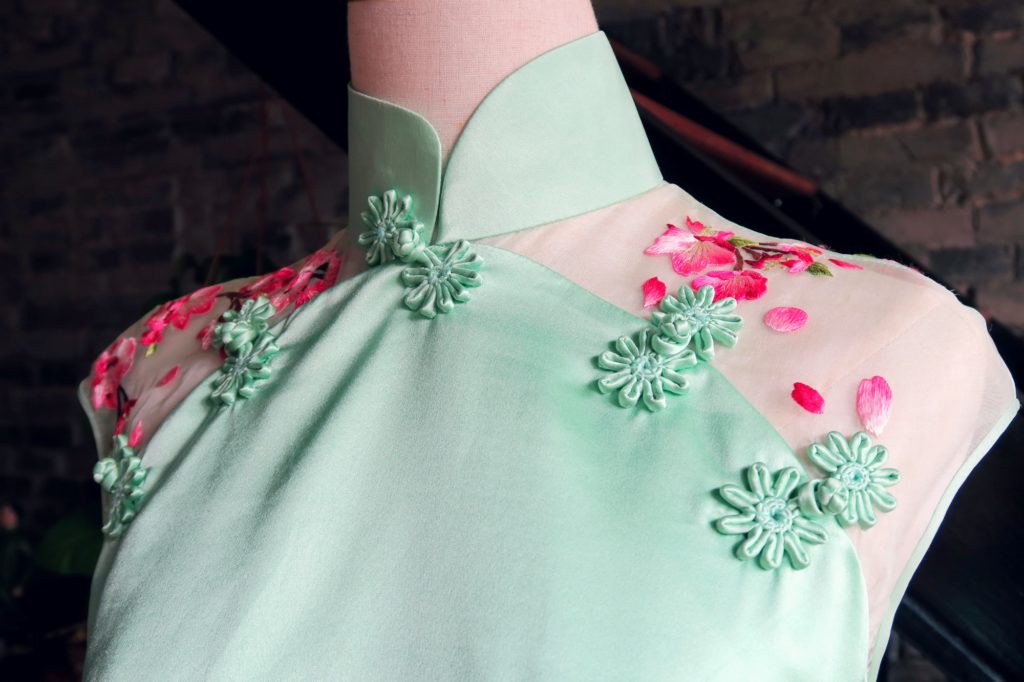
The qipao (cheongsam) front is unsurprisingly, the front piece of the dress, which starts from below the collar and extends down to the hem. Typical the front is made from two or three pieces of materials, joined together diagonally at the chest area by a series of pankous (traditional Chinese knot buttons). In my mint green wedding qipao pictured above, I chose a double sided front, matched with floral pankous.
The front piece of the qipao is called the large front (大襟), or simply front (襟). Typical the front is made from two or three pieces of materials, joined together diagonally at the chest area by a series of pankous (traditional knot buttons). This is also traditionally how a qipao is put on and taken off, the diagonal opening extends all the way down the side, and is like the front opening of a shirt which is buttoned up.
This diagonal opening of the front, along with the pankous, is one of the most distinguishing features of a qipao. In fact, the two are quite inextricably linked. The shape of the front often determines the type of pankou used, and the type of pankou chosen often influences the shape of the front.
Before starting research for this piece, I had never systematically thought about all the possible front shapes for a qipao, despite having seen many of them. But once I started compiling and listing, I became quite astonished at the possibilities.
To make it a bit easier to digest, I have grouped them into a few broad categories that you will see below. But the easiest way to think about it is that the front is either single sided or double sided. Single sided fronts can be placed on either side of the dress, called the right-opened front piece(右开襟)or left-opened front piece(左开襟), although the right is by far the most common.
As I mentioned already, traditionally the front is secured together by pankous, although snap buttons became widely popular from the 40s onwards. In one of my favourite qipao films, In the Mood for Love (see of all the dresses from the film here), pretty much all of Maggie Cheung’s qipaos are secured by snap buttons. Today both methods are in use, so it is really up to you what you choose. My personal opinion is that snap buttons are great when you want to focus attention on other details, so choose these when you have a strong print, interesting embellishments, or just trying to keep things simple. Otherwise go for the pankous.
Single sided under-arm qipao front
This is the simplest and most often used group of fronts. All of the fronts in this group run from the base of the centre of the collar to just underneath the armpit of one side of the qipao. Where they differ is in the shape of the slanted edge.
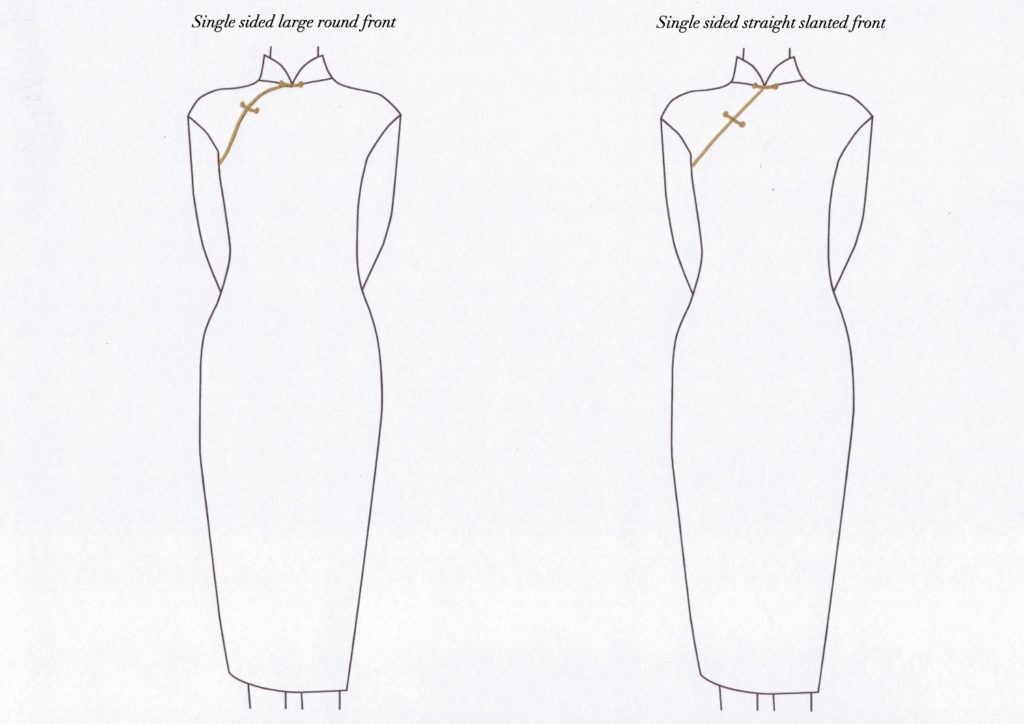
- Large round front(大圆襟)- this is the most commonly used front, and as the name suggests, the slanted edge takes on the shape of a large downward facing arc. This front is suitable with or without pankous. This is the front I chose for my red and white qipao that I wore to my pre-wedding banquet.
- Straight slanted front (斜襟) – this is a very simple front, with the slanted edge in a straight, diagonal line. This front is also suitable with or without pankous.
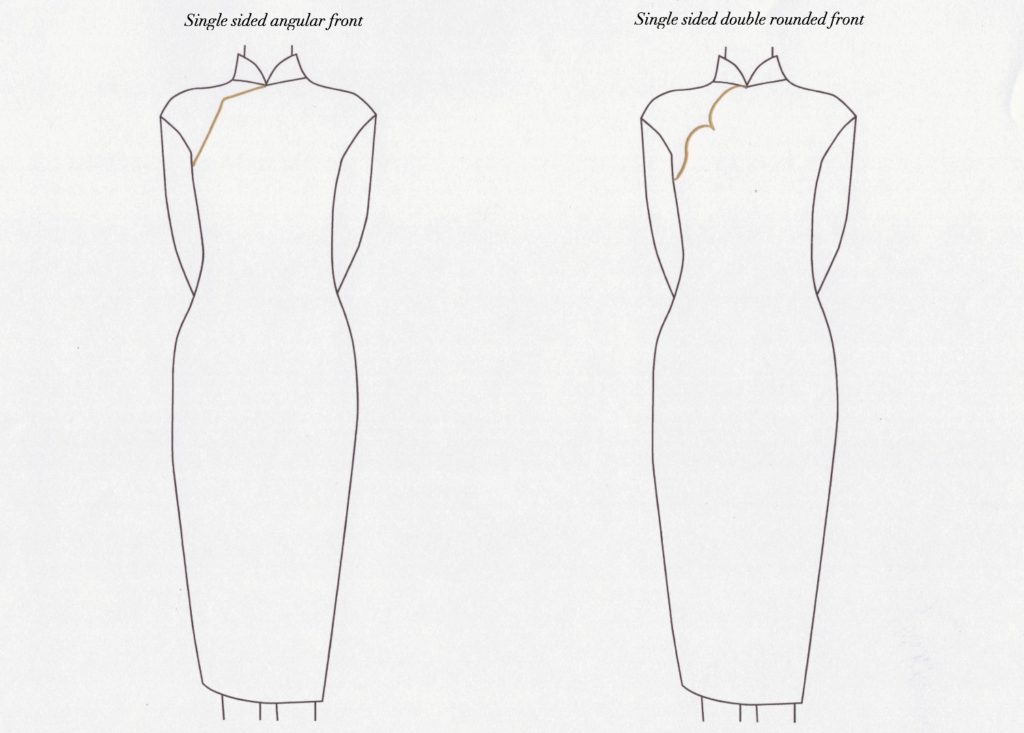
- Angular front (方襟) – this is one of my favourites, where the edge slants into an obtuse angle, the angular edges creating an elegant contrast to the roundness of the mandarin collar. I think this front is best without pankous, so that the silhouette of the angle can be in full view.
- Double rounded front(双圆襟)- this is a more decorative front, where the slanted edge takes a wave-like form, with two adjacent arcs. A pankou is usually placed at the centre, between the two arcs.
Single sided waist-length qipao front
In this group, the front runs from the base of the centre of the collar to the waist of one side of the qipao, again with variations in the shape of the edge. As the length of the edge tends to be fairly long, these fronts are best with pankous to break up the length.
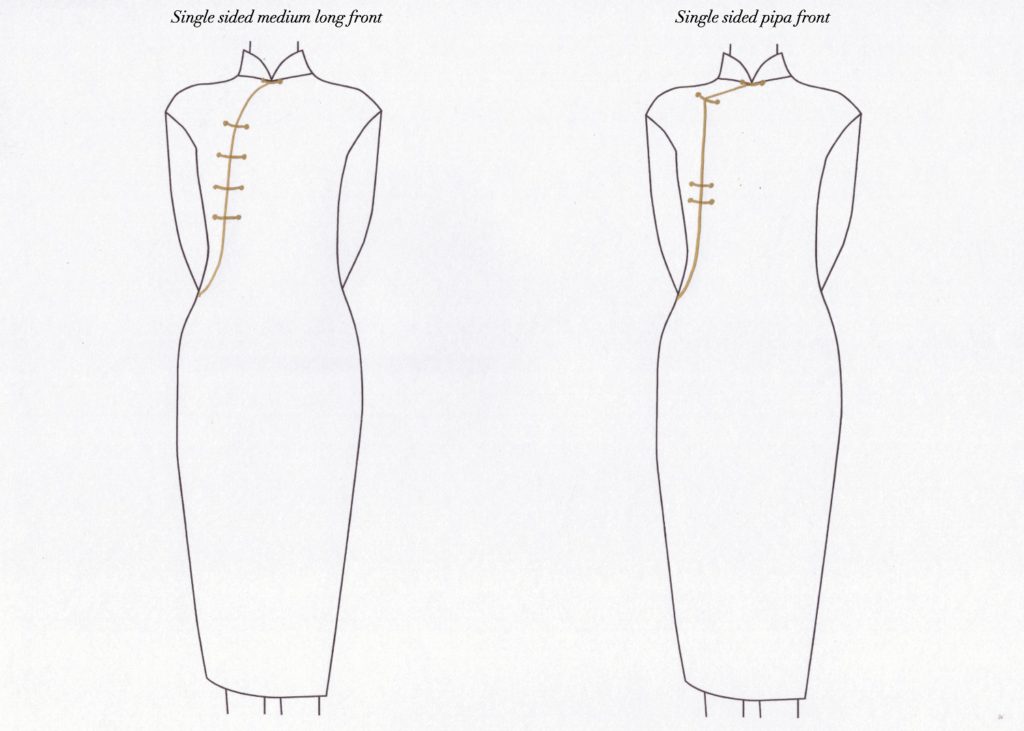
- Medium-long front (中长襟) – the name of this front is not the most descriptive, but the long slanted edge is in a smooth S shape, curved outwards towards the shoulders, and then inwards at the waist, before joining the side of the dress at the waist.
- Pipa front (琵琶襟) – this is essentially a longer version of the angular front described in the previous category, where an obtuse angle is formed by the front near the shoulders, and then there is a long, straight edge down to the waist area.
Single sided full-length qipao front
The front here runs from the base of the centre of the collar all the way down the length of the qipao to the very bottom hem, and does not connect with the side at all. I have only been able to find one variation of this length so far.

- Straight front(直襟)– this is the full length version of the angular front, with the obtuse angle formed near the shoulders, and a long, straight edge extending from one side of the angle all the way down to the hem. This is the front that is most suitable for showcasing pankous, as the column of pankous which would usually be stitched at the side is instead stitched all down the front, and could be quite a statement.
Double sided under-arm qipao front
The front here has two symmetrical, slanted edges, both starting at the base of the centre of the collar, and extend to either side of the body. In most cases, the dress can actually only be opened on one side, while the other side is stitched together, created purely for decorative purposes. The double sided front styles were favoured by the late Madam Song Mei-ling, especially in her older years.
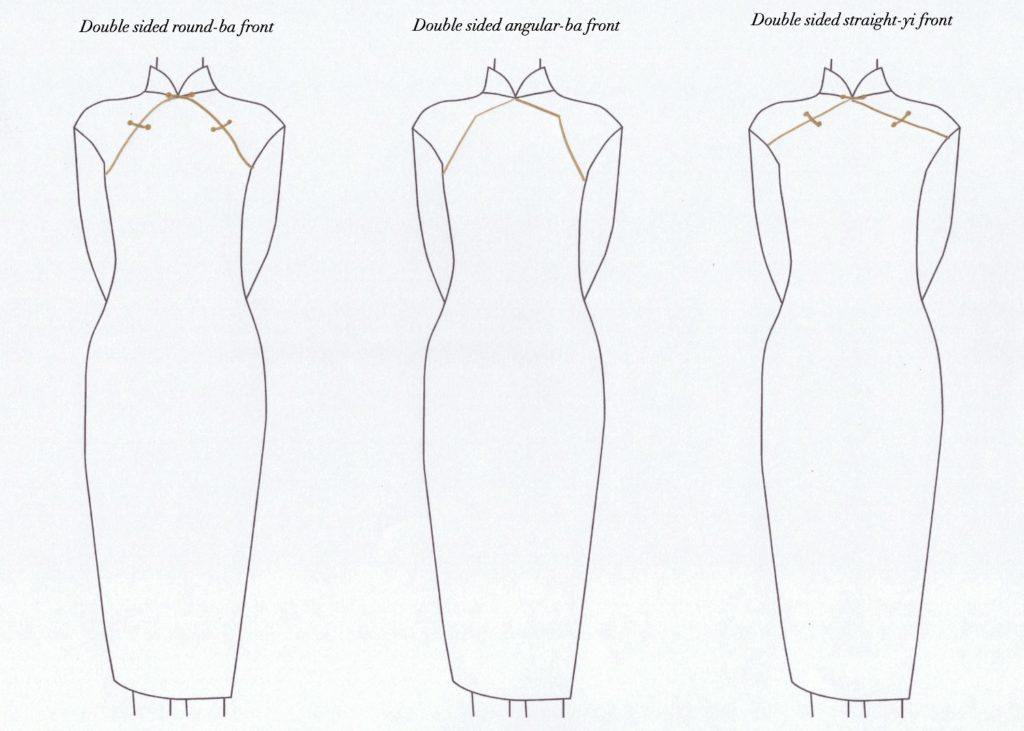
- Round ba-front(圆八字襟)– this is the most common double front style, and is essentially the dual-sided version of the single sided large round front, with the two edges of the front being two large arcs. It is named after the Chinese character for the number eight, in Chinese “ba” (八), whose written form resembles exactly how this front looks. It is suitable with or without pankous. This is also the front that is featured as the main image for this post, and the one I chose for my mint green wedding qipao.
- Angular ba-front (方八字襟) – this is the dual-sided version of the single sided angular front, and the name is quite self-explanatory. I also prefer this front without any pankous.
- Straight yi-front (一字襟) – this front starts from the base of the centre of the collar, and instead of curving and extending to underneath the armpits on either sides of the body, the front takes on a straight shape, extending to the middle of the shoulders on either side. It is therefore appropriately named after the number one, in Chinese “yi” ( 一), whose character is a simple straight line. This front is most often adorned with pankous.
Ruyi front(如意襟)
The phrase ruyi (如意) in Chinese literally means “as intended (desired, wished)”, and a Ruyi traditionally refers to a curved scepter which is suppose to bestow good fortunes. The Ruyi has a long “3” (or double-c) shaped handle and a large, decorative head that is said to be inspired by a cloud, lotus or immortality mushroom (灵芝/靈芝). The shape of this head is often used as a decorative motif in Chinese art.
In the case of the ruyi front, the ruyi head pattern is used on the shoulder and chest portion of the qipao. It is usually made from a more elaborate material, and affixed onto the qipao as an embellishment.
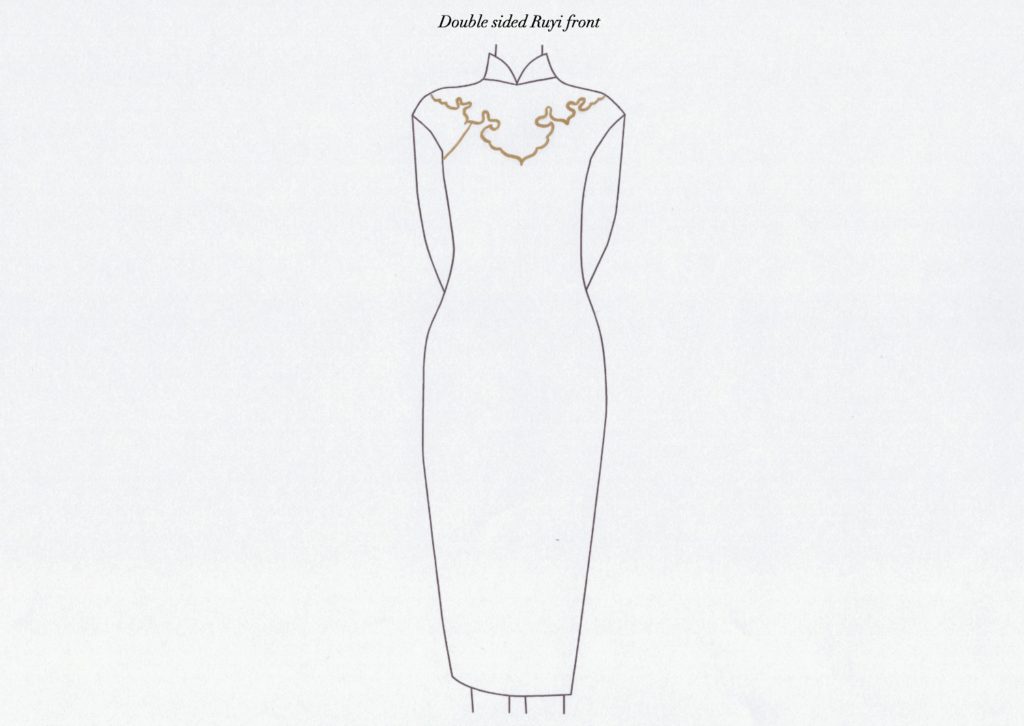
The ruyi pattern is symmetrical, so the ruyi front is in fact a special and highly decorative form of the double sided under-arm front. As is the case with the other double sided fronts, the ruyi front opens on only one side despite its double sided pattern.
No front
All traditional qipaos required a front so that the dress could actually be buttoned and unbuttoned to wear and take off. But as revised qipaos became popular, some dresses began to be made without a front, and were fastened with a zipper at the back or side instead.
These qipaos generally have some statement embellishment around the neck and chest areas which look better without the distraction of a front, or are designed to be worn with a jacket, which pairs much better with a plain front.
Of course, what I have summarised here is only a subset of what is possible. Every style here can also be tweaked in numerous ways, creating something new yet again. What I really need to do is to use the pankous I have left from my pankou post, and create a few front-pankou combinations for my wardrobe!
I’ve seen a variation on the singel sided full-lenght front where the clousrue goes all the way up to the shoulder. You can see one for sale her:
http://modernqipao.com/product/dark-purple-winter-long-cheongsam-silk-velvet-chinese-dress/
And if you scroll almost to the bottom of this article about a exebition about the qipao in 2010 you will see a beautifule blue and gold one:
https://rachttlg.com/2010/09/04/qipao-exhibition-hk-history-museum/
There is also this where they do sort of a wave pattern:
http://modernqipao.com/product/burgundy-floral-brocade-short-sleeve-mandarin-collar-dress/
But I don’t know if that last one should be counted separatly from the one you already mentioned?
Hi there, thank you so much for reading and posting!
You are right, the one where the closure goes all the way up to the shoulder is not one I’ve ever seen before, I suppose though it still needs to be buttoned at the shoulder and towards the neck, otherwise it cannot be taken off? So it is kind of a “shifted” singled sided straight front, where the normal angle bit above the chest is shifted to the shoulder.
For the third one it is kind of like a rounded front and a full length straight front mixed together.
I was only able to list most of the common fronts in this article, as you pointed out already there are so many other variations possible by mixing/matching and shifting. That’s part of the qipao’s beauty!